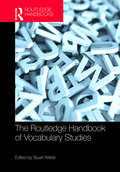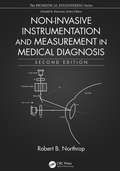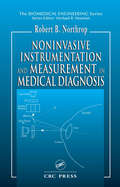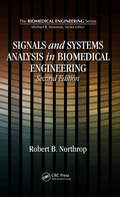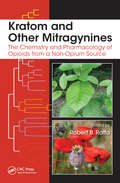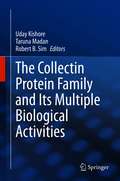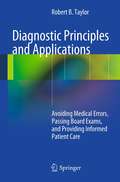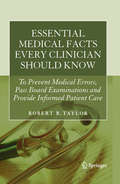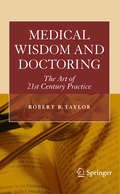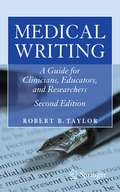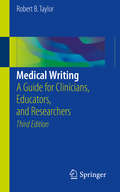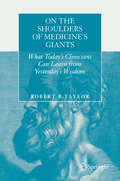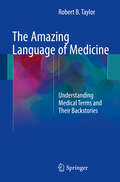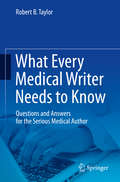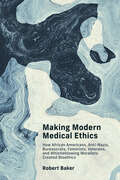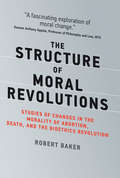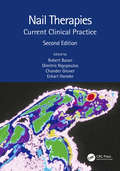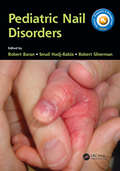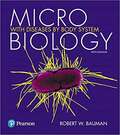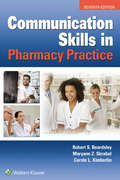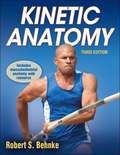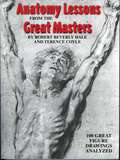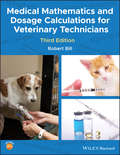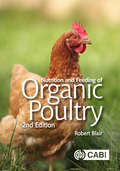- Table View
- List View
Introduction to Instrumentation and Measurements (Studies In Mathematical Thinking And Learning Ser.)
by Robert B. NorthropWeighing in on the growth of innovative technologies, the adoption of new standards, and the lack of educational development as it relates to current and emerging applications, the third edition of Introduction to Instrumentation and Measurements uses the authors’ 40 years of teaching experience to expound on the theory, science, and art of modern instrumentation and measurements (I&M). What’s New in This Edition: This edition includes material on modern integrated circuit (IC) and photonic sensors, micro-electro-mechanical (MEM) and nano-electro-mechanical (NEM) sensors, chemical and radiation sensors, signal conditioning, noise, data interfaces, and basic digital signal processing (DSP), and upgrades every chapter with the latest advancements. It contains new material on the designs of micro-electro-mechanical (MEMS) sensors, adds two new chapters on wireless instrumentation and microsensors, and incorporates extensive biomedical examples and problems. Containing 13 chapters, this third edition: Describes sensor dynamics, signal conditioning, and data display and storage Focuses on means of conditioning the analog outputs of various sensors Considers noise and coherent interference in measurements in depth Covers the traditional topics of DC null methods of measurement and AC null measurements Examines Wheatstone and Kelvin bridges and potentiometers Explores the major AC bridges used to measure inductance, Q, capacitance, and D Presents a survey of sensor mechanisms Includes a description and analysis of sensors based on the giant magnetoresistive effect (GMR) and the anisotropic magnetoresistive (AMR) effect Provides a detailed analysis of mechanical gyroscopes, clinometers, and accelerometers Contains the classic means of measuring electrical quantities Examines digital interfaces in measurement systems Defines digital signal conditioning in instrumentation Addresses solid-state chemical microsensors and wireless instrumentation Introduces mechanical microsensors (MEMS and NEMS) Details examples of the design of measurement systems Introduction to Instrumentation and Measurements is written with practicing engineers and scientists in mind, and is intended to be used in a classroom course or as a reference. It is assumed that the reader has taken core EE curriculum courses or their equivalents.
Non-Invasive Instrumentation and Measurement in Medical Diagnosis (Biomedical Engineering)
by Robert B. NorthropNon-Invasive Instrumentation and Measurement in Medical Diagnosis, Second Edition discusses NIMD as a rapidly growing, interdisciplinary field. The contents within this second edition text is derived from Professor Robert B. Northrop’s experience teaching for over 35 years in the Biomedical Engineering Department at the University of Connecticut. The text focusses on the instruments and procedures which are used for non-invasive medical diagnosis and therapy, highlighting why NIMD is the preferred procedure, whenever possible, to avoid the risks and expenses associated with surgically opening the body surface. This second edition also covers a wide spectrum of NIMD topics including: x-ray bone densitometry by the DEXA method; tissue fluorescence spectroscopy; optical interferometric measurement of nanometer tissue displacements; laser Doppler velocimetry; pulse oximetry; and applications of Raman spectroscopy in detecting cancer, to name a few. This book is intended for use in an introductory classroom course on Non-Invasive Medical Instrumentation and Measurements taken by juniors, seniors, and graduate students in Biomedical Engineering. It will also serve as a reference book for medical students and other health professionals intrigued by the topic. Practicing physicians, nurses, physicists, and biophysicists interested in learning state of the art techniques in this critical field will also find this text valuable. Non-Invasive Instrumentation and Measurement in Medical Diagnosis, Second Edition concludes with an expansive index, bibliography, as well as a comprehensive glossary for future reference and reading.
Noninvasive Instrumentation and Measurement in Medical Diagnosis
by Robert B. NorthropNoninvasive medical diagnosis (NIMD) is as old as medical practice itself. From the earliest healers' observations of odors, skin color, and breath sounds to today's wealth of technologies, the basics remain the same and keep the role of NIMD essential to effective medical care. Noninvasive Instrumentation and Measurement in Medical Diagnos
Signals and Systems Analysis In Biomedical Engineering (Biomedical Engineering)
by Robert B. NorthropThe first edition of this text, based on the author's 30 years of teaching and research on neurosensory systems, helped biomedical engineering students and professionals strengthen their skills in the common network of applied mathematics that ties together the diverse disciplines that comprise this field. Updated and revised to include new materia
Kratom and Other Mitragynines: The Chemistry and Pharmacology of Opioids from a Non-Opium Source
by Robert B. RaffaOpioids such as morphine, codeine, and oxycodone are extracts or analogs isolated from a single source: the opium poppy. For a long time, it was believed to be nature's only source of opioids. But it now appears that biological diversity has evolved an alternative source of opioid compounds-those derived from the plant Mitragyna speciosa. This plan
The Collectin Protein Family and Its Multiple Biological Activities
by Robert B. Sim Uday Kishore Taruna MadanThe topic of this book, Collectins, is a family of proteins whose major function is in innate immunity, where Collectins act as pattern recognition receptors (PRRs). In general they recognize targets such as microbial surfaces and apoptotic cells, and once bound to a target, Collectins promote the clearance of microorganisms and damaged host tissue. New cell-surface proteins and glycoproteins, which act as Collectin receptors, are currently being identified. Some Collectins, particularly MBL, activate the complement system, which enhances the ability of antibodies to fight pathogens, via three MBL-associated proteases, the MASPs. Additionally, recent research has begun to show wider-ranging activities of Collectins, such as: · Their role in metabolism, and therefore their involvement in lifestyle diseases such as obesity and cardiovascular disease.· Their ability to modulate the adaptive immune response, as well as to recognize and trigger apoptosis of cancer cells, which makes them effective in the annihilation of cancer cells with multiple mutations.· The regulation of their expression by gonadal steroid hormones implicates them with critical roles in both male and female fertility.· Altered levels of Collectins have been associated with various autoimmune diseases.This book brings together current knowledge of the structure, functions and biological activities of Collectins, to describe their integral role in human health.
Diagnostic Principles and Applications
by Robert B. TaylorThis book fills the need for a resource presenting important diagnostic facts that clinicians should have learned during their classroom lectures and subsequent clinical training, but often didn't. The content will be literature-based information that can help the clinician avoid diagnostic errors. Most other diagnosis books on the market are either "physical diagnosis" texts targeting student readers or "differential diagnosis" books intended for use by practicing physicians, though both types of books aim to be comprehensive. What sets this book apart from other diagnosis books is that it is a curated collection of facts, tailored specifically to address common gaps in clinical knowledge and describe less-traveled pathways to important diagnostic destinations. This book focuses on high-impact techniques. Essential Diagnostic Facts Every Clinician Should Know contains: -Classical diagnostic pearls clinicians should have learned in physical diagnosis courses. For example, a patient with acute pericarditis may find that leaning forward relieves the pain. -Red flag symptoms of serious disease. For example, an infant that tastes salty when kissed might be the first clue to a diagnosis of cystic fibrosis. -Pathognomonic signs allowing an occasional early diagnosis: For example, Koplik spots in a febrile child are found only with measles. -Plastic pearls exposed: For example, contrary to clinical lore, back pain at night has not been found to be a useful indicator for serious spinal pathology. -Counterintuitive clinical manifestations: For example, the patient with gout may have a normal or even low serum uric acid level during an acute attack. -Clinical manifestations that may point to uncommon diagnoses: For example, nocturnal bone pain, sometimes dramatically relieved by aspirin, characterizes osteoid osteoma.
Essential Medical Facts Every Clinician Should Know
by Robert B. TaylorEssential Medical Facts presents selected literature-based information clinicians need to know to provide informed patient care and avoid medical misadventures. Facts that can help make us better and safer clinicians include knowing the usefulness of palmar crease pallor in detecting anemia (not reliable), antibiotics that can cause a false positive opiate urine drug screen (fluoroquinolones), and an occasional early clue to testicular cancer (gynecomastia). Of course, keeping up to date on current medical knowledge and being curious about the implications of published research conclusions not only help assure superior clinical performance; they also bolster the preparation for board examinations. Robert B. Taylor, MD is the author and editor of more than two dozen medical books and several hundred published articles, as well a veteran of both rural private practice and chairmanship of a medical school clinical department. Essential Medical Facts is written for clinicians in all specialties, at all stages of professional life. It is a "must have" book for students, residents and practicing physicians, as well as nurse practitioners and physician assistants actively involved in clinical diagnosis and management of disease.
Medical Wisdom and Doctoring
by Robert B. TaylorMedical Wisdom and Doctoring aims to fill a need in the current medical literature for a resource that presents some of the classic wisdom of medicine, presented in a manner that can help today's physicians achieve their full potential. This book details the lessons every physician should have learned in medical school but often didn't, as well as classic insights and examples from current clinical literature, medical history, and anecdotes from the author's long and distinguished career in medicine. Medical Wisdom and Doctoring: the Art of 21st Century Practice presents lessons a physician may otherwise need to learn from experience or error, and is sure to become a must-have for medical students, residents and young practitioners.
Medical Writing
by Robert B. TaylorThe first edition of this book (titled "The Clinician's Guide to Medical Writing") has become a standard in its field and remains an indispensible reference for any clinician, academic physician, or health professional who wishes to hone their writing skills. However, since its publication in 2004, significant changes have taken place in the way medical professionals communicate with each other and the world. Medical Writing: A Guide for Clinicians and Academicians, 2e retains all of the fundamental writing advice of the first edition and has been expanded to include two brand new chapters: How to Write a Research Protocol (including why a research project needs a written protocol, elements of the research protocol and common problems) How to Write a Grant Proposal (including sections on government and private grant funding sources, what you need to know about grant writing, and elements of a successful grant proposal) New information is also included throughout the book on becoming a successful writer, medical tables and figures, conflict of interest and disclosures, how to review a scientific article, statistical analysis, "pay-to-publish" journal publishing, electronic submission of manuscripts, issues in medical publishing and the future of medical writing and publication. New appendices address commonly encountered research and statistical terms and memorable aphorisms regarding writing, medical and otherwise.
Medical Writing
by Robert B. TaylorThis book is for the clinician who wants to write. It is for the physician, physician assistant, or nurse practitioner who sees patients and who wants to contribute to the medical l- erature. You may be an assistant professor aspiring to p- motion or a clinician in private practice who seeks the personal enrichment that writing can bring. If you are new to medical writing or even if you have been the author of some articles or book chapters and seek to improve your abilities, this book can help you. Who am I that I can make this assertion and write this book, both fairly presumptuous? Here's my reasoning. As a practicing physician, writing has been my avocation; unlike the authors of many other writing books, I am not a journal editor. Over 14 years in private practice and 26 years in a- demic medicine, I have written all the major models described in this book: review articles, case reports, edito- als, letters to the editor, book reviews, book chapters, edited books, authored books, and reports of clinical research st- ies. Most have been published. Not all. Perhaps my most signi'cant quali'cation is not that I have managed to p- duce a lengthy curriculum vitae. In my opinion, what is more important for you, the reader, is that I have made all the errors. That's right, the mistakes.
On the Shoulders of Medicine's Giants
by Robert B. TaylorMedical history offers us many wise thoughts, a few misguided notions, and a host of intriguing back-stories. On the Shoulders of Medicine's Giants presents a selection of these, and tells how the words of medicine's "giants"--such as Hippocrates, Sir William Osler, Francis Weld Peabody, and Elizabeth Kübler-Ross--are relevant to medical science and practice in the 21st century. Which physician was the inspiration for the fictional character Sherlock Holmes, and what did he identify as "the real essential factor in all successful medical diagnosis"? What did Sigmund Freud describe as his "tyrant," and what might this mean for doctors today? Do you know the attributed source of the well-known aphorism about horses and zebras, and what we believe this physician actually said? This book answers these questions and more, while also providing fascinating tales about each individual quoted. On the Shoulders of Medicine's Giants is recommended for practicing physicians, students, and residents, as well as nurse practitioners, physician assistants, and anyone involved in patient care who wants to understand the historical and epistemological foundations of what we do each day in practice.
The Amazing Language of Medicine
by Robert B. TaylorThis book tells the intriguing and often colorful stories of the medical words we use. The origins of clinical and scientific terms can be found in Greek and Latin myths, in places such as jungles of Uganda and the islands of the Aegean Sea, in the names of medicine's giants such as Hippocrates and Osler, and in some truly unlikely sources. In this book you will learn the answers to questions such as: * What disease was named for an American space flight? * Do you know the echoic word for elephantine rumbling of the bowels? * What drug name was determined by drawing chemists' notes out of a hat? * What are surfer's eye, clam digger's itch, and hide porter's disease? This book can give you new insights into the terms we use every day in the clinic, hospital, and laboratory. Knowing a word's history assists in understanding not only what it means, but also some of the connotative subtleties of terms used in diagnosis and treatment. The Amazing Language of Medicine is intended for the enrichment of physicians, other health professionals, students, and anyone involved in clinical care and medical science.
What Every Medical Writer Needs to Know
by Robert B. TaylorThis book presents must-know facts generally not covered in "How To" books about medical writing. Every medical writer, whether a beginner or veteran, needs answers to questions many might not even know to ask. How does your personality type influence your writing behavior, and what can you do to make writing easier for you? What should you ask before agreeing to co-author an article for publication or write a book chapter? What are some of the current issues regarding copyright and plagiarism that authors may face? What has research discovered about the quotations and references found in journal articles? What do you need to know about open access journals and predatory publishers? Dr. Taylor tells some surprising truths about medical publishing, including possible sources of peer review bias and some alarming influences on what ends up in print. He also relates little-known stories about renowned medical writers such as Sir William Osler, William Carlos Williams and Elisabeth Kübler-Ross and the origins of some of medicine's classic publications. What Every Medical Writer Needs to Know provides information vital for every health care professional who aspires to write for others to read: academicians and practicing physicians; nurses, nurse practitioners and physician assistants; and professional medical and scientific writers.
Making Modern Medical Ethics: How African Americans, Anti-Nazis, Bureaucrats, Feminists, Veterans, and Whistleblowing Moralists Created Bioethics (Basic Bioethics)
by Robert BakerThe little-known stories of the people responsible for what we know today as modern medical ethics.In Making Modern Medical Ethics, Robert Baker tells the counter history of the birth of bioethics, bringing to the fore the stories of the dissenters and whistleblowers who challenged the establishment. Drawing on his earlier work on moral revolutions and the history of medical ethics, Robert Baker traces the history of modern medical ethics and its bioethical turn to the moral insurrections incited by the many unsung dissenters and whistleblowers: African American civil rights leaders, Jewish Americans harboring Holocaust memories, feminists, women, and Anglo-American physicians and healthcare professionals who were veterans of the World Wars, the Cold War, and the Vietnam War.The standard narrative for bioethics typically emphasizes the morally disruptive medical technologies of the latter part of the twentieth century, such as the dialysis machine, the electroencephalograph, and the ventilator, as they created the need to reconsider traditional notions of medical ethics. Baker, however, tells a fresh narrative, one that has historically been neglected (e.g., the story of the medical veterans who founded an international medical organization to rescue medicine and biomedical research from the scandal of Nazi medicine), and also reveals the penalties that moral change agents paid (e.g., the stubborn bureaucrat who was demoted for her insistence on requiring and enforcing research subjects&’ informed consent). Analyzing major statements of modern medical ethics from the 1946–1947 Nuremberg Doctors Trials and Nuremberg Code to A Patient&’s Bill of Rights, Making Modern Medical Ethics is a winning history of just how respect and autonomy for patients and research subjects came to be codified.
The Structure of Moral Revolutions: Studies of Changes in the Morality of Abortion, Death, and the Bioethics Revolution (Basic Bioethics)
by Robert BakerA theoretical account of moral revolutions, illustrated by historical cases that include the criminalization and decriminalization of abortion and the patient rebellion against medical paternalism.We live in an age of moral revolutions in which the once morally outrageous has become morally acceptable, and the formerly acceptable is now regarded as reprehensible. Attitudes toward same-sex love, for example, and the proper role of women, have undergone paradigm shifts over the last several decades. In this book, Robert Baker argues that these inversions are the product of moral revolutions that follow a pattern similar to that of the scientific revolutions analyzed by Thomas Kuhn in his influential book, The Structure of Scientific Revolutions. After laying out the theoretical terrain, Baker develops his argument with examples of moral reversals from the recent and distant past. He describes the revolution, led by the utilitarian philosopher Jeremy Bentham, that transformed the postmortem dissection of human bodies from punitive desecration to civic virtue; the criminalization of abortion in the nineteenth century and its decriminalization in the twentieth century; and the invention of a new bioethics paradigm in the 1970s and 1980s, supporting a patient-led rebellion against medical paternalism. Finally, Baker reflects on moral relativism, arguing that the acceptance of “absolute” moral truths denies us the diversity of moral perspectives that permit us to alter our morality in response to changing environments.
Nail Therapies: Current Clinical Practice
by Robert BaranEdited by Robert Baran, MD Honorary Professor, University of Franche-Comté; Nail Disease Center, Cannes, FranceDimitris Rigopoulos, MD, PhD Professor of Dermatology-Venereology, School of Health Sciences,National and Kapodistrian University of Athens, Greece Chander Grover, MD, DNB, MNAMS Professor of Dermatology, University College of Medical Sciencesand GTB Hospital, Delhi, India; Department of Dermatology, Inselspital, University of Bern, Switzerland Eckart Haneke, MD Dermatology Practice Dermaticum, Freiburg, Germany; Centro de Dermatología Epidermis, Instituto CUF, Porto, Portugal; Kliniek voor Huidziekten, Universitair Ziekenhuis, Ghent, Belgium A succinct guide to treatment options, both medical and surgical, for both disorders and injuries of the nail. From reviews of the first edition:"This is a book about nail therapies that is relevant clinically while remaining a manageable size. It would be a useful tool for all clinicians managing nail disease, from the trainee to those embarking on a clinic dedicated to nail disease." Br J Dermatol Contents: Anatomy and physiology of the nail unit * Psoriasis * Onychomycosis * Novel and emerging pharmacotherapy and device-based treatments for onychomycosis * Lichen planus * Onychotillomania (onychophagia, habit tic, median canaliform onychodystrophy) * Eczema * Acrodermatitis continua of Hallopeau * Herpes simplex (herpetic whitlow, herpetic paronychia) * Acute paronychia * Chronic paronychia * Warts * Yellow nail syndrome * Onycholysis * Nail fragility and beautification * Nail prostheses * Nail pigmentation * How to prevent and treat chemotherapy-induced nail abnormalities * Intralesional nail therapies * Drug side effects on the distal phalanx * Classical nail surgery and removal of the proximal nail fold * Surgery of some common nail tumors * Nail surgery complications * The painful nail * Radiation and the nail
Pediatric Nail Disorders (Pediatric Diagnosis and Management)
by Robert Baran, Smail Hadj-Rabia, Robert SilvermanThis is a highly illustrated guide to the diagnosis and management of nail conditions in children. With new material on genetics and on developments such as dermoscopy, it will be invaluable as a reliable clinical reference for both dermatologists and pediatricians, as well as those in family practice.
Microbiology With Diseases By Body System
by Robert BaumanKEY MESSAGE: Designed for pre-nursing and allied health readers, Microbiology with Diseases by Body System, 2/eretains the hallmark art program and clear writing style that have made Robert Bauman's book a success. Filled with intriguing content based on cutting-edge research that engages readers, the Second Edition features increased clinical coverage as well as a strong focus on the beneficial effects of microbes. Media Manager 2.1 provides instructors with the most robust media program available in the microbiology market for dynamic classroom presentations. In addition to all of the art, photos, and tables from the book in JPEG or PowerPoint format and customizable PowerPointlecture outlines, Media Manager 2.1 also includes 115 brief animations that depict complex microbial processes. These animations also appear on The Microbiology Place Website, with quizzes, for readers. <P><P>KEY TOPICS: A Brief History of Microbiology, The Chemistry of Microbiology, Cell Structure and Function, Microscopy, Staining, and Classification, Microbial Metabolism, Microbial Nutrition and Growth, Microbial Genetics, Recombinant DNA Technology, Controlling Microbial Growth in the Environment, Controlling Microbial Growth in the Body: Antimicrobial Drugs, Characterizing and Classifying Prokaryotes, Characterizing and Classifying Eukaryotes, Characterizing and Classifying Viruses, Viroids, and Prions, Infection, Infectious Diseases, and Epidemiology, Innate Immunity, Adaptive Immunity, Immunization and Immune Testing, AIDS and Other Immune Disorders, Microbial Diseases of the Skin and Wounds, Microbial Diseases of the Nervous System and Eyes, Microbial Cardiovascular and Systemic Diseases, Microbial Diseases of the Respiratory System, Microbial Diseases of the Digestive System, Microbial Diseases of the Urinary and Reproductive Systems, Applied and Environmental Microbiology. MARKET: For all readers interested in microbiology.
Communication Skills in Pharmacy Practice: A Practical Guide For Students And Practitioners
by Robert BeardsleyPublisher's Note: Products purchased from 3rd Party sellers are not guaranteed by the Publisher for quality, authenticity, or access to any online entitlements included with the product. Newly focused on the practical communications skills student pharmacists need for effective practice, this updated Seventh Edition—now in full color— reflects new ACPE standards, including up-to-date coverage of the PPCP model, co-curricular experiences, interprofessional interaction and collaboration, and professional development. Practical, easy-to-use, and packed with relevant case studies and coverage of the latest advances in the field, this edition is ideal for the foundational course and pre-experiential training.
Kinetic Anatomy (Third Edition)
by Robert BehnkeCreated primarily for those who will work in physical activity fields, the third edition of Kinetic Anatomy continues to building on its previous editions to assert itself as the ideal resource for learning structural anatomy and how it affects movement. The text gives students a firm concept of musculoskeletal anatomy by systematically assembling each component of the human body. Layer by layer, readers will study bones, ligaments, joints, and muscles on the bones, as well as the nerves and blood vessels that supply these muscles that are essential for movement. Kinetic Anatomy, Third Edition, includes coverage of three major structures that are not often considered when studying the anatomy of movement: the brain, heart, and lungs. As the centerpieces for the nervous, cardiovascular, and respiratory systems, these structures are essential to human movement and are highlighted throughout the text where appropriate. In addition, other fundamental features make this resource a valuable tool for learning and teaching human anatomy: - A one-year subscription to Musculoskeletal Anatomy Review, an online anatomy program, provides an interactive forum for reviewing regional structural anatomy. - A new chapter on the head completes the regional approach followed in the text. - More information on muscle and motor units helps broaden information on movement potential in selected sport activities. - Expanded discussion on joint strength and movement and the function of muscles (agonists, antagonists, stabilizers, and synergists), levers, and exercise supports understanding of how the human body is constructed. - Full-color photos and illustrations enhance the learning experience. - New Functional Movement Exercises provide students with the opportunity for practical application of their studies by asking them to identify the prime mover, antagonist, fixator, and synergist muscle in a particular movement. - Hands On exercises throughout the book offer students practice in physically identifying anatomical structures on themselves or on a partner. Included with each new text is a key code allowing students one-year access to the online anatomy program Musculoskeletal Anatomy Review. This engaging supplement to the text offers a regional review of structural anatomy with exceptionally detailed, high-quality graphic images--the majority provided by Primal Pictures. Students can mouse over muscles and click for muscle identification, and each chapter features a pretest and posttest evaluation to help students pinpoint knowledge gaps and test their retention. The pretest can be taken multiple times and is generated randomly so it will never be the same, but the posttest may be taken only once. Test results can be printed and turned in so instructors have the option to use the tests as a grading tool. To further facilitate learning, each chapter in the book concludes with a review of the key terms referred to in the chapter, suggested learning activities, and review questions in multiple-choice and fill-in-the-blank formats. The answers to the questions are provided at the end of the book. For instructors, a new image bank accompanies the updated instructor guide and test package to aid in delivering the course content. Kinetic Anatomy, Third Edition, is an outstanding introductory resource for those who plan to specialize in any field related to physical activity. Readers will learn what structures are involved in movement and how those structures should function, allowing them to identify problems and correct them to enhance physical activity.
Anatomy Lessons from the Great Masters
by Robert Beverly Hale Terence CoyleThis classic book, whose foremost author was one of the great artistic anatomy teachers of the twentieth century, is an invaluable instructor and reference guide for any professional, amateur, or student artist who depicts the human form. Revealing the drawing principles behind one hundred inspiring masterpieces, the book presents work by Leonardo, Michelangelo, Rubens, Raphael, Titian, Rembrandt, and other greats.
Medical Mathematics and Dosage Calculations for Veterinary Technicians
by Robert BillThis user-friendly guide to medical mathematics helps veterinary technician students develop the math skills required before going into the practice setting. New workbook format allows readers to practice problems right inside the book Covers math fundamentals, metric and non-metric conversions, dosing and concentration, IV drug infusion, prescriptions, and doctors' orders Offers step-by-step instructions for performing calculations Newly expanded to include calculation of constant rate infusions, dilutions, compounding, and anesthesia applications Features a full answer key and images from the book in PowerPoint for instructors on a companion website
Nutrition and Feeding of Organic Poultry
by Robert BlairOrganic poultry production has increased significantly in recent years to keep up with increasing consumer demand for organic eggs and meat. There are many guidelines and restrictions on what should go into the feed of organically-farmed poultry, from which difficulties arise when trying to ensure a well-balanced nutritious diet without the use of any unapproved supplements. This, the second edition of Robert Blair's classic and bestselling book on the nutrition and feeding of organic poultry, presents advice for organic producers, and the agencies and organizations serving them. It covers: - Selecting suitable ingredients. - Preparing appropriate feed mixtures and integrating them into organic poultry production systems. - International standards for organic feeding. - Breeds that are most suitable for organic farming. - Examples of diets formulated to organic standards. Completely updated and revised to address how to formulate organic diets in situations where there is a declining supply of organic feed, this new edition also includes up-to-date information on the nutritional requirements of poultry and feed-related disease incidence in organic flocks. Also including the feasibility of utilizing novel feed, such as insect meal, and their acceptability by consumers of organic meat products, this book forms a comprehensive reference for students, organic farmers, veterinarians and researchers.
Nutrition and Feeding of Organic Poultry
by Robert BlairOrganic poultry production has increased significantly in recent years to keep up with increasing consumer demand for organic eggs and meat. There are many guidelines and restrictions on what should go into the feed of organically-farmed poultry, from which difficulties arise when trying to ensure a well-balanced nutritious diet without the use of any unapproved supplements. This, the second edition of Robert Blair's classic and bestselling book on the nutrition and feeding of organic poultry, presents advice for organic producers, and the agencies and organizations serving them. It covers: - Selecting suitable ingredients. - Preparing appropriate feed mixtures and integrating them into organic poultry production systems. - International standards for organic feeding. - Breeds that are most suitable for organic farming. - Examples of diets formulated to organic standards. Completely updated and revised to address how to formulate organic diets in situations where there is a declining supply of organic feed, this new edition also includes up-to-date information on the nutritional requirements of poultry and feed-related disease incidence in organic flocks. Also including the feasibility of utilizing novel feed, such as insect meal, and their acceptability by consumers of organic meat products, this book forms a comprehensive reference for students, organic farmers, veterinarians and researchers.
